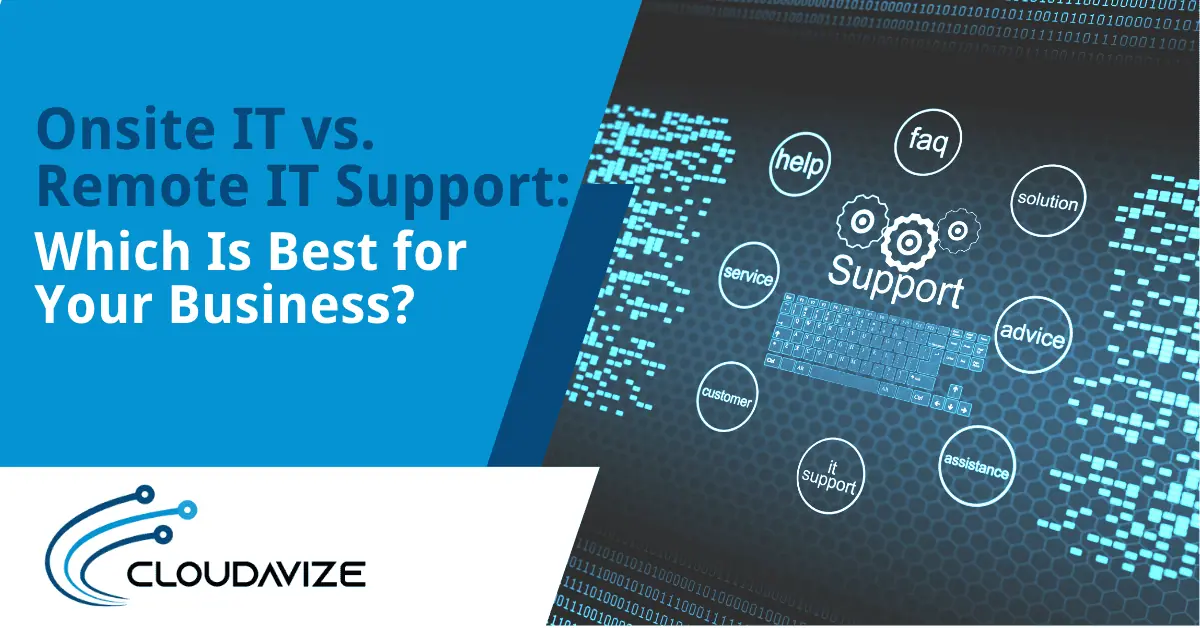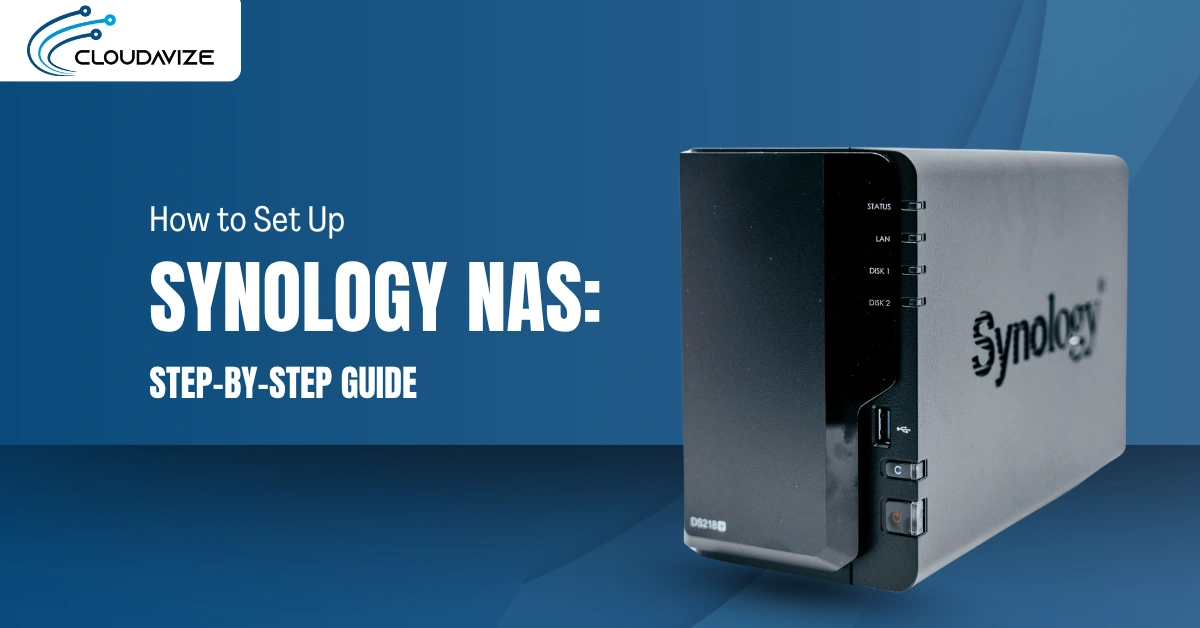Deciding between onsite and remote IT support is critical for modern businesses aiming for efficiency and robust technical backing. Each model offers distinct benefits and drawbacks, impacting how your business handles IT issues.
Onsite IT support provides direct, physical technical assistance at your company’s location. This is indispensable for dealing with complex hardware problems or high-security data concerns, where immediate, hands-on solutions are crucial. Conversely, remote IT support offers a more flexible and cost-effective approach, allowing issues to be managed and resolved through digital communication technologies. This model excels in scalability and logistical efficiency, making it ideal for businesses with multiple locations or those requiring frequent software updates and system checks.
In this article, we will cover the essential factors to consider when choosing between onsite and remote IT support, including scenario-specific needs, cost implications, scalability, and security issues, to help you determine the best fit for your business.
Table of Contents
What is Onsite IT Support?
Onsite IT support refers to immediate technical assistance provided directly at a business’s location. This form of support is crucial for handling complex hardware issues and critical system failures where quick response times are vital to prevent extended downtime. Onsite teams are capable of rapid diagnostics and quick resolution, which are essential in high-stakes environments where every second counts.
The presence of IT professionals within the company premises allows for faster identification and rectification of IT issues, which minimizes disruptions to operations and enhances overall business productivity. This setup ensures that IT infrastructure remains aligned with the evolving needs of the business, providing a dynamic and responsive approach to IT management.
What are the Pros and Cons of Onsite IT Support?
Onsite IT support offers immediate issue resolution, significantly reducing downtime and potential revenue losses when IT failures occur. Technicians present onsite can directly address and rectify issues, ensuring personalized service that meets the unique operational needs and technology infrastructure of each business. This approach not only resolves problems effectively but also enhances user satisfaction and system reliability. It also excels in managing hardware-related security concerns with rapid response capabilities crucial for mitigating risks effectively during security breaches.
Despite its benefits, onsite IT support comes with higher costs due to salaries, training, and infrastructure expenses, which may be prohibitive for smaller businesses. Its limited global reach can also pose challenges for companies operating internationally, and dependency on the availability of skilled IT professionals can delay critical updates and repairs, potentially exacerbating issues.
Pros of Onsite IT Support
The benefits of onsite IT support extend beyond swift problem-solving; they also include the ability to provide tailored IT solutions and access to specialized expertise necessary for managing sophisticated systems. This presence enables direct and complete control over IT systems, with solutions that can be customized on the fly to meet the unique needs of the business. Furthermore, teams can manage security breaches and implement protocols instantly, offering an unmatched advantage in maintaining robust security measures.
The advantages of Onsite IT Support are discussed below:
- Immediate Issue Resolution: Onsite IT support excels in providing immediate troubleshooting and resolving issues, crucial in critical operational scenarios where any downtime directly impacts revenue. IT professionals present onsite can quickly address and solve problems, an advantage particularly in situations requiring urgent hardware resets or other physical actions that remote IT support cannot instantaneously handle.
- Personalized Support: Personalized support through onsite IT services offers tailored technical assistance that closely aligns with a business’s specific needs. This approach enhances understanding and solution accuracy, leading to improved outcomes and increased customer satisfaction. Unlike remote IT support, onsite assistance enables direct personal interaction, which is especially beneficial in complex IT environments where remote services may struggle to achieve the same level of personalization.
- Enhanced Security: Onsite IT support provides robust security by allowing direct, hands-on access to hardware systems. This capability is vital for scenarios like system lockdowns, direct interventions in data breaches, and physical inspections. These actions are crucial for maintaining high-security standards and addressing potential vulnerabilities that remote support models might expose, especially in sensitive hardware configurations.
Cons of Onsite IT Support
Onsite IT support offers immediate, personalized assistance but has significant drawbacks, including high costs from deploying technicians, travel expenses, and space requirements. Its limited global reach and scheduling dependencies can also restrict businesses with multiple or international locations, leading to potential delays and disrupting business continuity.
- Higher Costs: Onsite IT support often incurs significant expenses that can impact a business’s budget, especially for smaller or mid-sized companies. These costs include travel expenses for technicians to reach your location, higher hourly rates for immediate or emergency services, and the necessity for physical space to accommodate an IT staff. Such expenses can substantially increase overall IT spending, making onsite support a less favorable option for companies with tighter financial constraints.
- Limited Global Reach: The effectiveness of onsite IT support is restricted by geographical limitations. Technicians can only provide support where they can physically travel, which poses a significant challenge for businesses operating in multiple locations or across global markets. This limitation can hinder the consistency and availability of IT support needed to maintain seamless business operations in different regions.
- Time-Sensitive Scheduling: Coordinating onsite IT support visits requires managing schedules that align with both the availability of technicians and the urgency of IT needs. This can lead to scheduling challenges that might delay necessary IT interventions, potentially extending system downtime and negatively impacting business operations. The inherent delay in waiting for onsite support can be particularly problematic for businesses that require immediate resolutions to maintain operational continuity.
What is Remote IT Support?
Remote IT Support is the provision of IT assistance from a distance, utilizing network connections to handle tasks like software updates, system diagnostics, and issue resolution. This method allows IT professionals to manage and rectify issues without being physically present at the location of the hardware, offering a flexible and efficient solution to businesses worldwide.
This support model significantly reduces logistical costs and eliminates the constraints associated with physical presence, making it ideal for businesses with operations spread across multiple locations or countries. Remote IT support enables continuous system monitoring and preventive maintenance, ensuring that potential issues are addressed proactively, which is crucial for maintaining uninterrupted business operations. Additionally, it offers the advantage of around-the-clock availability, which is essential for businesses that operate on a 24/7 basis
What are the Pros and Cons of Remote IT Support?
Remote IT support offers cost-effectiveness, scalability, and proactive monitoring, making it ideal for businesses with multiple locations or extensive software needs. However, its effectiveness depends heavily on reliable internet connectivity, with any disruptions significantly impacting service. Additionally, remote access increases security risks, introducing potential cybersecurity threats. Businesses must weigh these advantages against the risks when considering remote IT support.
Pros of Remote IT Support
Remote IT support offers significant advantages for businesses. Its cost-effectiveness minimizes expenses related to onsite operations, while scalability allows companies to adjust IT services without physical constraints. Additionally, the logistical convenience of remote support enables efficient problem-solving across multiple locations. Enhanced by proactive monitoring and access to global experts, remote IT support provides effective solutions that can preemptively address issues and improve overall IT service quality.
A detailed information on four of the major benefits of Remote IT Support is given below:
- Cost-Effective Solutions: Remote IT support dramatically reduces operational costs by eliminating the expenses associated with travel and onsite visits. Furthermore, it lowers manpower needs and reduces the infrastructure required at the company’s physical location. These reductions in overhead are not only beneficial in trimming the budget but also enhance the overall profitability of the business. This efficient use of resources allows companies to allocate funds more effectively, optimizing budgets to support other critical areas of the business or to invest in new technology.
- Scalability and Flexibility: Remote IT support excels in its ability to seamlessly scale services to meet the evolving demands of any business. This model enables adjustments to IT support levels without the necessity for on-site hardware changes or extensive preparatory work, making it exceptionally well-suited for businesses experiencing growth spurts or variable demand cycles. The flexibility of remote support ensures that resources are efficiently aligned with current needs, facilitating rapid adaptation to new challenges or opportunities, and providing a robust foundation that supports continuous business development and adaptation to market changes.
- Proactive Monitoring: Remote IT support teams are equipped to continuously monitor and maintain your IT systems from afar. This constant vigilance allows them to detect and resolve potential issues before they disrupt business operations. Regular maintenance and updates are performed to ensure systems operate at peak efficiency. The proactive approach not only decreases the likelihood of downtime but also extends the lifespan of IT assets. This strategic monitoring plays a crucial role in maintaining business continuity and enhancing the reliability of technology-dependent processes.
- Access to Specialized Experts: Leveraging remote IT support opens the door to a vast network of global IT experts, offering specialized skills that might not be readily available in the local job market. This access is crucial for staying abreast of the latest technological advancements and integrating state-of-the-art solutions into your business. The expertise brought by these professionals can drive innovation, enhance system security, and ensure that your IT operations are in line with the best practices in your industry. This strategic advantage can be a game-changer, setting your business apart from competitors and positioning it as a leader in utilizing cutting-edge technology solutions.
Cons of Remote IT Support
While remote IT support provides advantages like cost efficiency and adaptability, it also presents certain challenges, including a heavy dependence on continuous, high-quality network connections that, if unstable, can lead to increased downtime and operational disruptions. Below are the primary drawbacks of this approach:
- Dependence on Network Connectivity: Remote IT support is fundamentally dependent on the availability and reliability of network connections. When these connections are stable, support can be efficient and seamless; however, any instability or disruptions in connectivity can significantly increase downtime. This dependence can lead to challenges in maintaining consistent IT operations, especially during network outages or performance issues.
- Potential Security Concerns: Remote IT support inherently introduces several security risks that need vigilant management. Key vulnerabilities include the potential for data interception during transmission and unauthorized breaches into the IT systems through remote access points. These risks necessitate the implementation of comprehensive and sophisticated cybersecurity measures.
How Do You Choose Between Onsite and Remote IT Support?
Choosing onsite IT support is advisable for businesses requiring immediate technical assistance and high-level security for complex hardware issues, while remote IT support is more suitable for companies seeking cost-effective, scalable solutions for software-centric environments and widespread operations.
When navigating the decision between onsite and remote IT support, businesses must critically assess various factors to ensure alignment with their operational requirements and strategic goals. Here’s a deeper look at key considerations:
- Nature and Frequency of IT Issues: If your issues are predominantly hardware-related, such as server failures, wiring issues, or hardware installations and upgrades, onsite support is invaluable. Technicians can provide immediate, hands-on assistance, reducing downtime and ensuring complex equipment is handled correctly. Conversely, if your challenges are primarily software-related, including updates, bug fixes, and security patches, remote support can be highly effective. It allows for quick, often automated solutions that can be implemented without the need for physical presence, ensuring a swift resolution that minimizes interruption to operations.
- Business Size and Geographical Spread: For large enterprises or businesses with complex IT needs, onsite support is invaluable for addressing immediate technical issues directly at the company’s location. This approach is particularly beneficial for businesses concentrated in one geographic area, allowing for quick deployment of IT professionals. However, onsite support might not be cost-effective for smaller businesses or those spread across multiple locations due to higher travel and operational costs.
- Security Needs: From a security perspective, onsite support offers the advantage of direct control over physical hardware, making it preferable for high-security needs. However, remote support excels in continuous monitoring and quick response to software-related security threats, albeit dependent on robust cybersecurity measures to mitigate risks of cyber-attacks.
- Cost Implications: Onsite IT support typically involves higher upfront costs, including salaries, benefits, and travel expenses for IT staff. These costs can be justifiable for businesses requiring frequent, specialized intervention that remote support cannot adequately provide. However, for many businesses, particularly small to mid-sized enterprises, remote IT support offers a more cost-effective solution. It reduces the need for physical space and on-premises personnel, cuts down on travel expenses, and can be scaled up or down based on demand without significant financial overhead.
Conclusion
Both onsite and remote IT support models have their place in modern business operations. Your choice should align with your business’s operational needs, budget constraints, and strategic IT goals. Understanding the pros and cons of each will equip you to make an informed decision, ensuring your managed IT support aligns perfectly with your business requirements. Remember, the right IT support setup not only resolves technical issues efficiently but also supports your business’s growth and adaptation in a digital landscape.



